Daffodil flower specifications
- Botanical Name : Narcissus spp
- Order : Asparagales
- Family : Amaryllidaceae
- Subfamily : Amaryllidoideae
- Tribe : Narcisseae
- Genus : Narcissus
- Plant Type : Bulb, perennial
- Mature Size : 6–30 in. tall, 6–12 in. wide
- Sun Exposure : Full, partial
- Soil Type : Rich, moist but well-drained
- Bloom Time : Late Winter, Spring
- Flower Color : Yellow, white, orange, pink
- Native Area : Europe, North Africa
Iran daffodil ( Narcissus pseudonarcissus ) : Daffodil ( Narcissus spp. ) are among the most popular, easy-growing spring-flowering perennial bulbs. These bulbs thrive in climates with a winter chill since the coming of spring, and warmer temperatures spur these flowers to emerge. When grown in warm regions, daffodils are often purchased as prechilled bulbs and planted as annuals. As one of the first flowers to arrive in early spring, daffodils symbolize renewal and hope and are a popular flower representing spring.
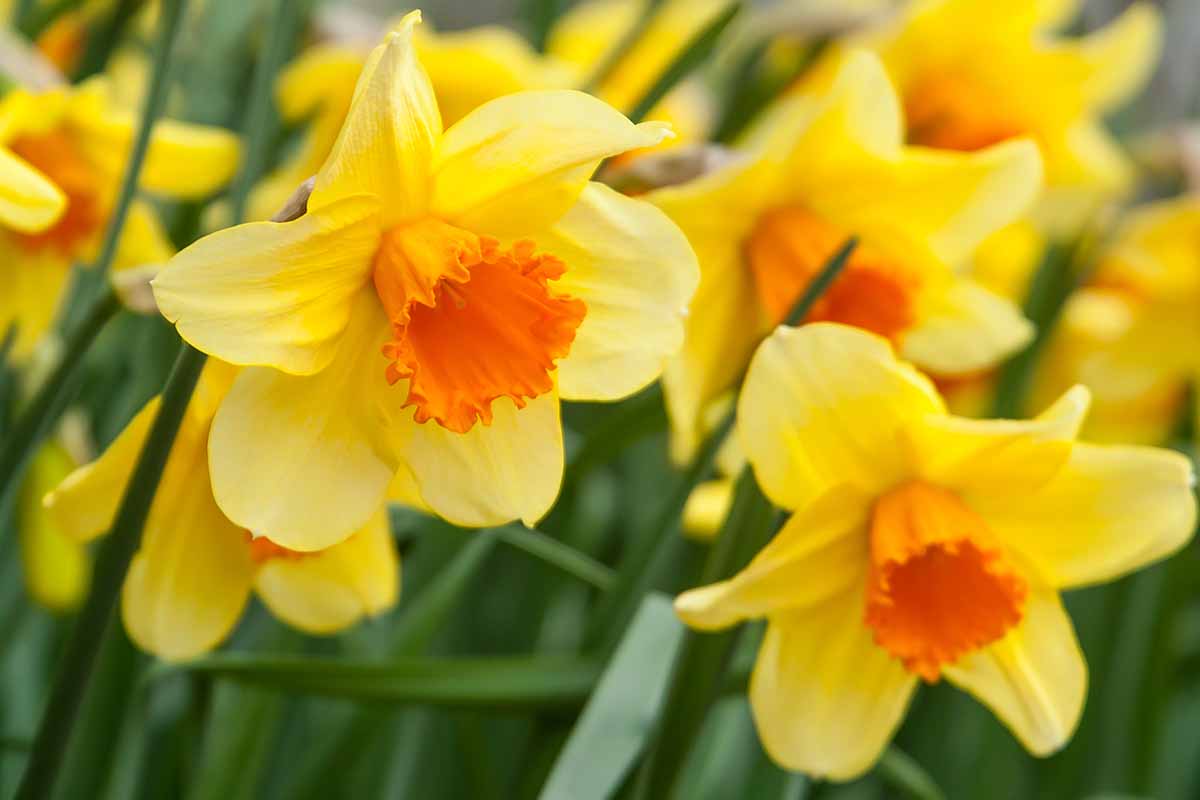
read more : Everything about hydrangeas : How to Plant & care for Hydrangea
Clusters of strappy leaves appear shortly after temperatures warm, followed by flowers with trumpet-shaped cups. Depending on the type of daffodil, the cup can be pronounced and large, small, split, or lampshade-like. Most varieties have yellow blossoms, but you can also find white, orange, pink, and bicolor cultivars.
Native to areas of Europe and North Africa, daffodils are best planted in mid to late autumn and will emerge in early spring, reaching peak bloom about a month before the average last frost date. Daffodils are toxic to both humans and animals.
The most important producers of daffodils in the world
The total area of daffodil cultivation in the world is 6,100 hectares with a production of 29 billion branches per year. Britain, the Netherlands, Iran, the United States, Canada, Spain and Portugal are among the world’s producers of daffodils. The total area of daffodil cultivation in Iran is 969 hectares and it is ranked third in the world after England and the Netherlands.
Iran also ranks 4th with 670 million flower branches after the United Kingdom, the Netherlands and the United States. Fars, Khuzestan, Golestan, Mazandaran, Lorestan, Semnan, Alborz, Ilam, Kerman, Tehran and parts of Hamedan and Markazi are among the provinces where daffodils are grown.
Export of daffodils from Iran
Daffodils flower is one of the most popular flowers among people and many people around the world cultivate it. Iran is one of the countries growing daffodils, whose main exports are to the Arab countries of the Persian Gulf and Central Asia. Iraq is one of the buyers of daffodils. For this reason, natural daffodils are exported to Iraq every year
Growing daffodils starts an economic cycle and creates jobs for a large number of people. Meanwhile, Iran daffodil export to other countries.
In addition to its decorative aspect, Daffodils flower has many usages in traditional medicine and perfume industry. The reasonable price of daffodils has caused the purchase and sale of export daffodils to bring huge profits to exporters and wholesalers of daffodils, and through this, it will also help the country’s economy and currency.
read more : Everything about miniature rose : How to Plant & care for them
Natural habitats in Iran
There are two types of daffodils. One type has a large crown and is a single flower, and the other type has a small crown and its flowers are clustered. Most Iranian daffodils are of the second category. The most famous type of daffodil in Iran is Shahla daffodil in Kazerun, which is known as Shirazi daffodil.
One of the main provinces for the production of Iranian daffodils is Fars province in the Jarreh and Baladeh regions of Kazerun , with 500 hectares of cultivated area and production of 300 million branches per year, which ranks first in the country.
Daffodils flower is also found in other parts of the country such as Behbahan, Khuzestan province, Khaf, Fars province and South Khorasan , while in some parts of Iran, the daffodil plant is present by car. In South Khorasan province, especially in Pirhajat village in Tabas city; daffodils is widely cultivated.
Much of daffodil fields in Fars province in the region, “teal”, “Bolbolak ” , ” Sar Mashhad”, “Famour” city with an opioid produce several variants. In these daffodils, four types of daffodils have been identified, and Shahla narcissus occupies a larger area of cultivated areas. Other types of feathers include sixty feathers, cat paws, and poor feathers.
Daffodils is famous for its beauty and special scent. In 1992 , he won the first place in the Dutch Flower Festival . But in Iran , due to lack of knowledge and lack of sufficient promotion of this plant and its origin, not enough information has been published and despite all the advantages that narcissus has, so far this flower has a small share of flower tourism.
This bulbous plant with a height between 30 to 45 cm and with 3 to 8 flowers blooms in winter. The flowering period of the narcissus is 45 days, ie from early January to mid-February.
Types of daffodils
Daffodils flowers did not have a specific classification and name until the 19th century, but after that, with the research done on daffodil flowers, they gave a special name to each of them. The most well-known types of this flower are Narges Shirazi and Narges Shahla, which are known for their white and yellow colors. But daffodils are not limited to these colors and the difference between these flowers in different species is due to the birthplace, the shape of the petals and their appearance.
read more : Everything about lavender flower : How to plant & care for them
-
Trumpet Daffodils
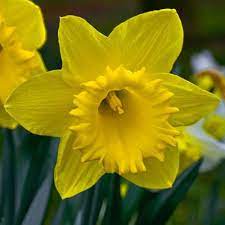
Trumpet daffodils
This type of daffodil is one of the most classic flowers. Trumpet daffodil is the best type of daffodil for paving the garden. Each branch contains a large, attractive yellow flower. Their leaves are usually green-gray and about 2-3 cm. If the daffodil flower horn was taller than its petals, it falls into this category.
This daffodil is found natively in Spain and Portugal. Today, however, the flower enters other regions and is mainly grown in: France, Italy, Turkey, the former Yugoslavia, and the states of British Columbia, Utah, Illinois, Ohio, and the southeastern United States from Texas to Maryland.
Wild Daffodils has long, slender and similar leaves. In late spring, 5 yellow and white flowers with a very good aroma appear on it. This plant is known as the parent of several varieties that fall into category 7 of the horticultural classification.
-
Dutch Daffodils or Daffodils jonquilla.
This species of daffodil has been cultivated in France since the 18th century and is known as the strongest species in the daffodil genus. It is extracted from Daffodils oil which is used in making many modern perfumes. In fact, it can be said that the name Junki was first mentioned by the French.
The planting time of these onions is suitable for early autumn to early spring. Onions require a brief cooling period.
-
Large Cupped Daffodils
This type of daffodil is the most resistant daffodil available and is suitable for almost any purpose. Due to the high resistance of this species, it can be used for special purposes, such as : paving the garden, bouquets, decorating the bride’s car, etc. He also has a great variety of colors: white, all shades of yellow, orange, red and pink. Each branch has a daffodil flower.
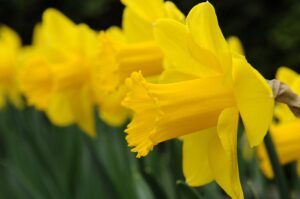
Large Cupped Daffodil
read more : Everything about aster flower : How to Plant & care for them
-
Double Daffodils
Instead of a horn, the center of the daffodil is made up of its own petals, making it a bit like a rose. Each stem of this flower can have about 20 daffodils on it. For this reason, it is very suitable for paving the garden or picking.
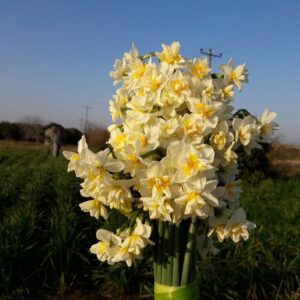
Double Daffodils
The full-grown daffodil is a perennial plant with bulbs. The flowers have a large number of petals from which a crown has emerged from the petals.
Daffodils flower of Shiraz is very fragrant and fragrant and the flowers are placed on the stem in the form of inflorescences.
This flower is extremely beautiful and does not require much care. The full Daffodils flower is excellent for planting in gardens, orchards, green spaces, pots and creates a very beautiful landscape.
This flower is also very suitable for use in bouquets and cut flower branches. Flowering is usually done in spring and the time of planting onions is in October and November.
-
Jonquilla Daffodils
This type of daffodil loves the scorching summer sun. For this reason, it is very suitable for the hot cities of our country. The onion of this flower adapts well to the environment and creates colorful and different daffodils. On each of its delicate green stems, several small fragrant daffodils grow.
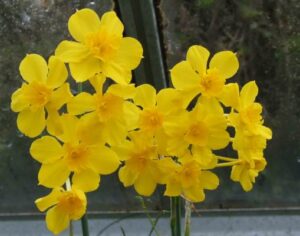
Jonquilla Daffodils
-
Miniature daffodils
This flower is a combination of different types of small daffodils that grow up to about 15 cm together. This flower is suitable for rock gardens, the distance between the roots of trees and stimulating the growth of garden plants.
If you have a balcony with good sunshade, you can plant this type of daffodil in a suitable pot, but you must protect it from freezing in winter. There are different bulbs for this flower, each of which produces more than two daffodil stems.
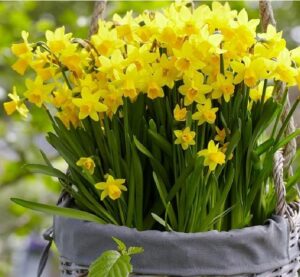
Miniature daffodils
-
Poeticus Daffodils
These bright flowers have white petals and a narrow red stripe adorns the tip of the middle horn. They have a slightly pungent odor and are one of the most resistant types of daffodils. They are suitable for colder areas and grow well in the garden. They are great for bouquets.

Poeticus Daffodils
-
Small cupped Daffodils
The beautiful color of this daffodil has made her a different and special flower. It has a long life and can continue to flower for many years. They are very suitable for decorating the garden and create a beautiful color combination with other spring flowers. You can also have them in twigs in your pot and bouquet. Each stem of this daffodil grows a flower. The trumpet is shorter than the other petals.
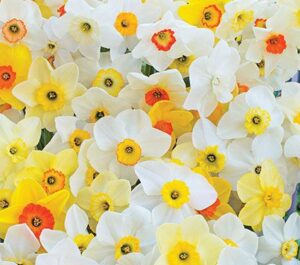
Small cupped daffodils
read more : Everything about sea lavender flower : How to Plant & care for them
-
Split corona Daffodils
This daffodil has a strange appearance and is not similar to other types of daffodils. The middle horn has a fissure in the middle and unlike other daffodils that have a closed horn, this horn has an open and free appearance. For this reason, most of them look more like marshmallows than marshmallows. This flower is very stunning and with its beautiful colors, it can give a different look to your garden.
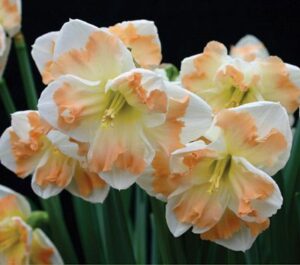
Split corona daffodils
-
Tazetta Daffodils
Tazetta Daffodils has a lot of small flowers on each stem. The aroma of this daffodil is sweet and pleasant. They can give you beautiful daisies for many years without reducing the number and quality. Like all types of daffodils, they are suitable for decorating the garden and you can even buy them as branches.
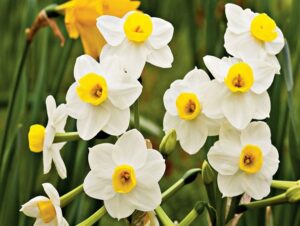
Tazetta daffodils
-
Triandrus Daffodils
Each stem of this daffodil has at least two beautiful flowers that are beautifully tied together and look a bit like a fuchsia flower. The outer petals are folded down, giving it a beautiful appearance. Daffodil triple has a pleasant and fruity smell. This flower is very suitable for garden, bouquet and paving.
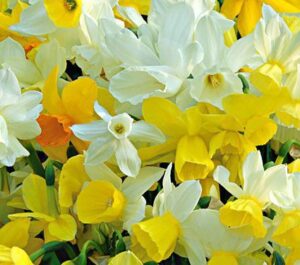
Triandrus daffodils
How to Plant Daffodil Bulbs
-
Choosing Bulbs
When selecting daffodil bulbs, choose ones that look healthy (no black spots) and have a large, firm shape with a dry papery covering. Discard bulbs that are withered and overly dry or soft and mushy. If you notice they’ve gone soft, rot has likely set in.
Plan on planting in groups of three or up to a dozen bulbs of one variety for them to make an impact.
-
When to Plant
For daffodils to develop their root system before the cold weather arrives, plant daffodils in mid to late autumn for flowers that will emerge the following spring. If cold weather arrives later in your area, you can plant as late as Thanksgiving.
-
Where to Plant
Consider using daffodils in a shrub border, perennial beds, or with your groundcovers. They also look lovely planted in front of evergreens, which will give them wind protection. If planted with southern exposure, for example, against a home or other foliage, they will flower earlier. They will also naturalize under deciduous trees, in a lawn, or in a meadow but you’ll have to refrain from mowing until the foliage dies down.
-
How to Plant
Plant the bulbs pointed end up, about 3 to 6 inches deep. If using light soil, bulbs can be planted about 8 inches deep.
The spacing between bulbs can be about 5 inches apart for an immediate, denser impact. If you’re more patient, space them about 12 inches apart, as the bulbs will spread and fill in spaces within a few years. Also, if you plant them closer together, consider digging up the bulbs every three to five years, as they can multiply, crowd, and compete for water and nutrients, affecting flowering.
read more : Everything about Scorpion grasses : How to Plant & care for them
Daffodil Care
Daffodils are a great entry-level plant for novice gardeners developing their green thumbs. Daffodils require little care other than watering during the active growing season and topdressing with bulb fertilizer in instances where the bulbs are not producing ample flowers.
Daffodils will not bloom more than once a season, so when you notice the petals fading, allow the foliage to turn yellow and dry up. Do not cut the foliage. It’s important to leave the leaves, as they absorb sunlight that helps feed the bulb for next year’s blooms.
After the leaves dry up, some gardeners dig up the bulbs, then save them until fall replanting time. This approach allows the space vacated by fading daffodils to be filled with other plants for the summer. Most gardeners, however, leave the daffodil bulbs in the ground, lifting and dividing them every fourth year or so.
-
Light
Daffodils thrive best when planted in full sun ( at least six hours ), though they can withstand a bit of partial shade or dappled light. These spring bloomers often do their display by the time deciduous trees have leafed out, so they can work well when planted in areas that will be shady by midsummer but with plenty of sun in the early season.
-
Soil
Daffodils prefer a neutral to slightly acidic soil pH of around 6.0 to 7.0 . They thrive in rich, moist soil but, as with most bulbs, they require excellent drainage, or they will rot. Daffodils should not be allowed to sit in waterlogged soil.
-
Water
Daffodils like to be watered regularly in the spring and fall. But stop watering in mid to late spring, about three to four weeks after the flowers fade. Daffodils go dormant during the summer and prefer drier soil at this time.
-
Temperature and Humidity
Daffodil hardiness will vary slightly depending on variety, but most daffodils are reliable within USDA hardiness zones 4 to 8. Most daffodils need a cold dormant period, so they’re planted in the fall.
Most types are not well suited for warm southern climates unless planted as annuals. However, certain divisions of daffodils (such as division 8, the Tazetta group) will grow in warmer temperatures, especially if given sufficient water. Overall, daffodils do equally well in humid and arid atmospheric conditions, provided soil moisture is appropriate.
-
Fertilizer
Daffodils are pretty self-sufficient, but if you have poor soil or the plants are not flowering as much as they should, top dress with bulb food when the leaves first emerge. Lightly feed again when they bloom. For the amount to use, follow the product label instructions.
Pruning
As the blooms fade, the top portion of each flower stem can be removed to prevent seed formation. But leave the foliage in place until it begins to yellow, as the plants restore the bulbs during this time. The leaves should be left undisturbed for at least eight weeks after the flower has bloomed.
Cutting Daffodils for a Vase
Daffodils are lovely as cut flowers. Here’s how to keep your garden daffodil plants alive and make a floral bouquet with daffodils last longer.
To keep your bulbs alive, use a sharp, sterile pair of scissors and cut the fleshy flower stem as close to the base of the leaves as possible at a 45-degree angle. Leave the leaves in the ground and allow them to brown on their own.
For your cut flower to last longer, immediately upon cutting, put the daffodils in a lukewarm vase of water. If adding daffodils to a bouquet of mixed flowers, it’s essential to allow them to leech their sap in the water separately for at least 30 minutes; when mixed with other flowers, their sap can diminish the longevity of the other flowers in your bouquet.
read more : Everything about cosmos flower : How to Plant & care for them
Propagating Daffodils
The easiest way to propagate daffodils is by lifting and removing the offshoot bulbs that form underground. This division is usually not necessary for the health of the plants, but it can be done every fourth year or so if colonies are overgrown.
Here’s how to do it :
- In summer, after the daffodil leaves have turned yellow and died, carefully dig up the clump and shake off the dirt.
- Set the bulbs in a shady location for at least two days to dry, then use your hands to separate the bulblets from the parent bulbs carefully. Discard any bulbs that are soft or notably damaged.
- The parent bulbs and offsets can be replanted immediately, at a depth 2 to 3 times their diameter, spaced 10 to 12 inches apart. Or, they can be stored until late summer and fall planting time, which can begin in late August.
Be aware that tiny offset bulbs will likely take several years to develop the vigor to produce flowers. Small bulbs will produce foliage for several years as they gain size, then begin to flower once they are sufficiently large.
How to Grow Daffodils From Seed
It can take as much as five or six years for daffodil seeds to grow into plants with viable bulbs. This method is rarely used, except by professionals or serious amateurs experimenting with hybridization. But should you have the patience to try it, seed propagation begins with harvesting seeds from the marble-sized pods left behind after daffodil flowers fade. When these seed pods shrivel and turn brown, you can break them open to extract the seeds inside.
Save the seeds until fall, then plant them about 1/2 inch deep in small pots or seed trays filled with potting mix or seed starter mix. Set the pots in a sheltered outdoor location to receive a winter chill period. In the spring, the seeds will germinate and sprout into tiny, grass-like seedlings. Continue to grow them in their small pots for at least three years. After this point, the plants will have small bulbs that must be systematically repotted into increasingly large containers each year. By year five or six, you will have bulbs that are sufficiently large to plant in the garden.
read more : Everything about corn flower : How to Plant & care for them
Potting and Repotting Daffodils
Daffodils can grow well in containers for up to three years if the pot is deep enough for its roots to fill out. With proper timing, you can grow potted daffodils for indoor winter flowering simply by controlling the timing of the chill period. To successfully plant daffodils in containers, follow these easy steps:
- Choose a pot that is about 2 gallons for standard daffodils and 1 gallon for small bulbs or miniature daffodils. Make sure your chosen pot has drainage holes. Fill the container about two-thirds of the way with a standard commercial potting mix.
- Disperse the bulbs in the pot — close, but not touching — so their points are just below the pot’s rim. Lightly cover the bulbs with soil and water well.
- Move the container to a cool, dark spot where the temperature remains steady, around 40 to 45 degrees Fahrenheit for 12 to 16 weeks. Water whenever the soil feels dry. This chilling period can be conducted outdoors in colder regions, or the pots can be chilled in a refrigerator for the required time.
- After the chilling period, when yellow shoots emerge, move the container to a sunny but cool spot ( around 50 to 60 degrees Fahrenheit ) and continue watering.
- When the shoots turn green, the container can be moved into brighter sunlight ( around 60 to 70 degrees Fahrenheit ). Top dress with a handful of fertilizer or bone meal. Continue watering whenever the soil feels dry, and be sure to turn the containers to promote even growth.
Place the pot on its side when the leaves die off and let it dry out. Then start all over again. Potted daffodil bulbs can bloom for two to three years in the container, but will do better if you move them to a spot in the ground and pot up fresh bulbs each year. While they are in the pot, remember that daffodils will need the required chilling cycle each year. They cannot be grown as perpetual houseplants.
Overwintering
When planted in their acknowledged hardiness range, daffodils usually don’t require winter protection against the cold. But overwintering recommendations can vary according to region. In regions with very cold winters but with no snow cover, growers often find that a layer of mulch will help ensure the survival of the bulbs.
Common Pests & Plant Diseases
Daffodils are famous for being almost immune to severe pest and disease issues. But on rare occasions, one of the following problems may occur :
Bulb rot is possible if daffodils are planted in poorly drained soil. Daffodils can also be affected by narcissus yellow stripe virus, which causes brown and yellow stripes on the foliage. Affected plants will need to be removed and destroyed.
Here are some potential pests to look out for :
- Narcissus flies lay eggs at the base of plants, which hatch and cause larvae to bore down into bulbs. You may well notice soft bulbs with worms inside during routine bulb division. Affected bulbs will need to be thrown away.
- Bulb mites cause the weakening of daffodils and are most likely with daffodils being grown indoors for seasonal display. Various spray pesticides will control them.
- Nematodes cause lumpy lesions on the foliage. There is no treatment for these microscopic soil worms, and you may even need to give up growing daffodils in soils where they are present.
read more : Everything about corn flower : How to Plant & care for them
How to Get Daffodils to Bloom
Daffodils are usually reliable spring bloomers if their basic cultural needs are met, as outlined above. When daffodils fail to bloom, look for one of these reasons :
- Daffodil foliage was cut back too soon. Daffodil foliage generally persists for four to six weeks after the blooms fade, and during this time, the bulbs are replenished as the leaves continue to conduct photosynthesis. If the foliage is cut back too soon, the result can be weakened bulbs that fail to bloom the following spring. This can be a significant problem when daffodils are naturalized in a lawn setting; if you mow your lawn too early in the spring, it can cut away the foliage before it has a chance to replenish the bulbs.
- Bulbs were planted upside down. If you planted good large bulbs but failed to flower in their first season, it’s possible they were planted upside down. The proper orientation is planting them with the pointy side facing up.
- Bulbs are too young. Especially after division, the smaller offset bulbs often do not flower for a year or two. With extremely small bulbs, it can take even longer.
- Soil is poor. Daffodils don’t require rich soil, but they do need some nutrition. Topdressing with a handful of bulb fertilizer in the fall may help prompt flowering the following spring. Be careful, though, as too much fertilizer can damage daffodil bulbs.
- Not enough sunlight. As surrounding shade trees grow larger, increasing amounts of shade may cause your daffodils to bloom less. Pruning surrounding bushes and trees to restore sunlight may help.
read more : Everything about rose flower : How to Plant & care for them
Common Problems With Daffodils
Daffodils are usually very reliable plants that cause few problems. One common complaint, though, is that the plants are not at all attractive once the flowers fade, leaving gaps in the landscape and wilted floppy foliage. This is unavoidable, as it is necessary to allow the foliage to die back naturally and entirely before removing it. One solution is planting daffodils in the spaces between other late-developing perennials; their leaves will gradually fill in the gaps once the daffodil foliage has finally died.
FAQ
-
How long do daffodils last?
On average, daffodils bloom for about six weeks. Depending on the cultivar and growing conditions, a succession of blooms can last up to six months. Once you cut a daffodil and put it in a vase in water, it can last up to two weeks. As for in-ground daffodil bulbs, most will return each spring for many years. A colony of naturalized daffodils can thrive for decades when given a light annual feeding with a granular bulb fertilizer.
-
What is the difference between a jonquil and a daffodil?
The term jonquil is correctly applied to only one Narcissus species, N. jonquilla, known for narrow, reed-like leaves and yellow flowers in which the center cup is at least 2/3 the length of the outer petals. Jonquils are among the daffodil species that are somewhat more tolerant of warmer southern climates.
-
How can I naturalize daffodils in my lawn?
You can easily naturalize early spring daffodils in your turf lawn. But you must limit your use of pre-emergent weed killers, which can kill off the daffodils before they even appear. If you use post-emergent weed killers, spot-spray individual weeds rather than broadcast spraying. Also, allow daffodil foliage to die back naturally; then, you can resume routine mowing when the daffodil foliage turns yellow and dies.
-
Are daffodils immune to rabbits, squirrels, and other animals?
The natural toxins in daffodils make them less likely to serve as food for deer, rabbits, and other animals. Planting daffodils among other vulnerable plants, such as tulips, can protect them. But plants are only partially immune to feeding animals when other food supplies are scarce.
-
Are daffodils easy to grow?
Daffodils need little care; they are easy to grow when given good drainage and medium-to-heavy loamy soil. Three easy steps for daffodil care :
- Provide a light feeding of bulb fertilizer in early spring.
- Ensure the soil never becomes waterlogged since it can cause the bulbs to rot.
- Allow the leaves to stay in the ground until they turn brown.
0 Comments